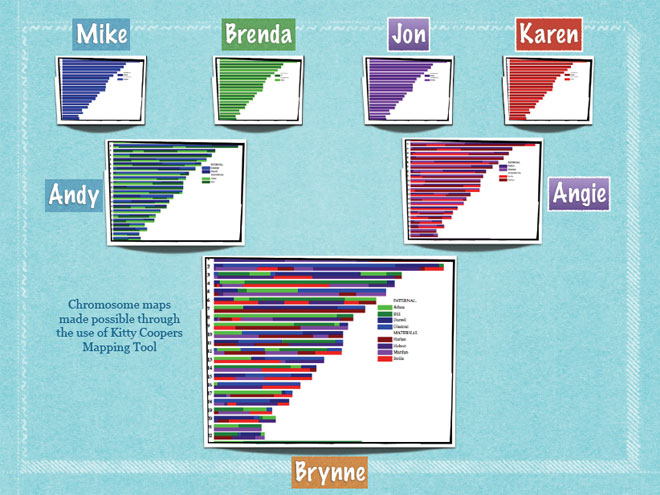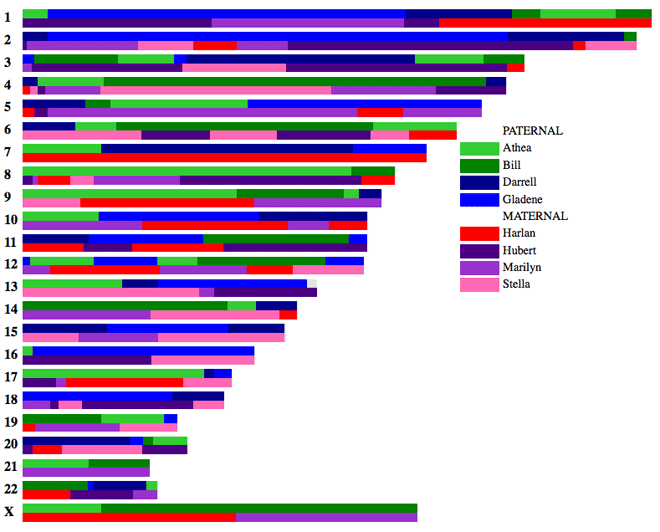My friend Angie Bush is a most creative genetic genealogist whose daughter Brynne is apparently following in her footsteps. They do a lovely presentation on autosomal DNA together which includes this slide showing four generations of DNA inheritance, made with my ancestor chromosome mapper.
Little did I know when Angie asked me for a feature to select the colors herself what a clever thing she had in mind. Each grandparent is shown in two colors, one for each of their parents. Those same colors are carried through on each chart so the names next to the colors on Brynne’s chart are those of her eight great-grandparents. How wonderful to have four generations of family tested.
Here is the close-up of the ancestor chromosome mapper chart for just Brynne:
Interesting that she has chromosome 21 intact from her paternal great-grandmother Marilyn. Also notice how little recombination occurred on her X chromosome.
This presentation called “Ancestors in DNA” was given near me at the Carlsbad DNA Special Interest Group (DIG) and has been submitted for a number of upcoming conferences. Check back here to learn when they will be giving it. I really look forward to going to this one!


Thanks Kitty!! Love this post!!!
I also have Chromosome 7 intact from my Maternal Great Grandfather Harlen
WOW, so you do! And that is much larger chromosome.
Brynne, Thank you so much for sharing this picture. It is really fascinating to see a real world example of how DNA is inherited.
I’m green with envy at Brynne’s chromosome map — how wonderful to be able to create something likethat. Those who have the opportunity to test their grandparents (or beyond) are extremely fortunate. I count myself very lucky that at my age both parents are still alive and have been tested.
I love being able to select my own colors on your mapping tools, Kitty, so thanks for adding that capability.
This is wonderful, but it is not clear to me how you are so certain where every bit comes from, even if none of it is endogamous. Surely not all eight great-grandparents were tested.
No, not all 8 were tested, but 6 of the 8 were. The two that were not tested were easily inferred.
Thanks Angie, we are all jealous that you have so many family members tested!
I’m trying to understand ged match.com. what does it mean when there are numbers/letters on the Mt haplogroup side and the Y haplogroup side? Then some just have numbers/letters on the Y haplotype side.
Angie (not Bush) – Those are the self-reported haplogroups so you would have to ask the individual if they make no sense.
Columns in the GEDmatch one-to-many are explained in the handout that goes with my slides (see http://blog.kittycooper.com/2014/08/my-presentation-on-gedmatch-tools-is-this-thursday-in-carlsbad-ca – perhaps you meant to comment there?)
Sorry for the typos, I’m on my cell.
I have looked at Brynne Gallup’s results and they are fairly typical of the average crossovers reported in the literature. An interesting result of the crossover frequency ratio between paternal meiosis and maternal meiosis being 1.6:1 is that average segment length is larger by 60% for paternal than maternal in each generation.
Thanks Bill, appreciated.
I am very interested in the mapping tool as I am trying to phase out my late father’s autosomal signature. I have my mother and sister, maternal uncle, one paternal grand parent pending and my daughter also pending, my mother in law is the only one out standing so I want to create a representative signature for my father to complete the match. OI have phased at Gedmatch but you can’t down load the signature unless I’ve missed the link.
I have a question where is the second X chromosome for the illustration above, as the one shown looks like its from a 50% contribution from the mother’s two X chromosomes, if I’m not mistaken the father contributes his X complete as the second X for his female children? Is there any way to get large copies of the charts to see how it all really fits together, like the Y chromosome for the male lines , and then mtDNA mother to daughter? The enlarge feature isn’t sufficient to read.
Is there a link to the Chromosome mapper and instructions?
Here is the link to the tool and instructions:
http://blog.kittycooper.com/tools/my-graphing-or-mapping-tools/chromosome-mapper/
When you actually run it, you can hover over the segments and save the html page to your computer. But perhaps you want to try the segment mapper?
http://blog.kittycooper.com/tools/my-graphing-or-mapping-tools/segment-mapper/